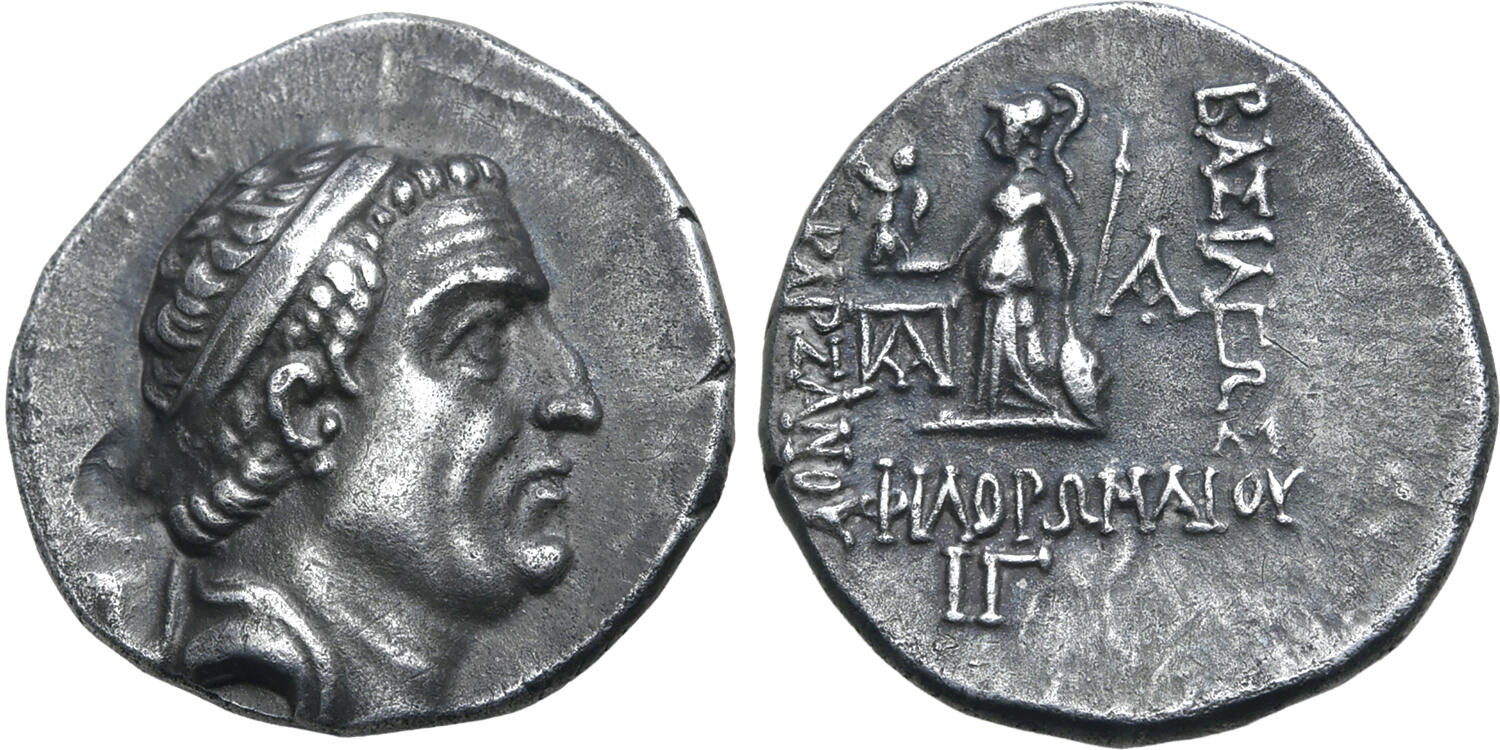Eusebeia (Ariobarzanes I), silver, drachms (Ariobarzanes/Athena nicephorus) (95-80 BCE)
From SILVER
95 BCE - 80 BCE Silver 9,967 kg
Description
| ObverseInscription or printing placed on the obverse.: | Diademed head to right |
| ReverseInscription or printing placed on the reverse.: | ΒΑΣΙΛΕΩΣ ΑΡΙΟΒΑΡΖΑΝOY ΦΙΛΟΡΩΜΑΙOY (Greek).Athena Nikephoros standing to left, monogram in inner left field, IΓ (date) in exergue |
Mint and issuing power
| MintIdentifies the place of manufacture or issue of a numismatic object.: | Eusebeia | Ancient regionAncient region.: | Cappadocia | Modern countryModern country: Turkey | AuthorityIdentifies the issuing power. The authority can be "pretended" when the name or the portrait of X is on the coin but he/she was not the issuing power. It can also be "uncertain" when there is no mention of X on the coin but he/she was the issuing power according to the historical sources: | Ariobarzanes I Philoromaios (96-63 BCE), Cappadocian kingdom |
Chronology
| FromIdentifies the initial date in a range assigned in a numismatic context. | 95 BCE | toIdentifies the final date in a range assigned in a numismatic context.. | 80 BCE | PeriodTime period of the numismatic object.: Hellenistic 323-30 BC |
Physical description
| MetalThe physical material (usually metal) from which an object is made.: | Silver |
Median weightMedian of the weights of numismatic objects (in grams). in grams | 4.10 | DenominationTerm indicating the value of a numismatic object. Examples: tetradrachm, chalkous, denarius.: | drachma |
StandardStandard.: | Attic |
Image

S1803 Ariobarzanes I drachms.jpg [1]
References
| Die study referencePublication of the study: | Callataÿ 1997a1Callataÿ 1997a, p. 209-211 | ||
| Coin series referenceReference to coin series study: | Sear II2Sear II, n° 7300-7302, HGC 73HGC 7, n° 847 | ||
Obverse dies distribution
no distribution is available
Reverse dies distribution
no distribution is available
Quantification
| Number of obversesNumber of obverse dies. ᵖ (o) | 67 | Number of singletons (o1)The number of singleton coins. ᵖ | |
| Number of reverse diesNumber of reverse dies. (r) | Number of coinsNumber of coins. (n) | 121 | |
| Coins per obverse dieNumber of coins per obverse die. (n/o) | 1.81 | Coins per reverse dieNumber of coins per reverse die. (n/r) | |
| Reverse per obverse ratioRatio of obverse dies divided by reverse dies. (r/o) | Percentage of singletons (o1)number of coins (n) divided by the number of singletons (o1) ᵖ | % | |
| Original number of dies (O) (Carter 1983 formula)The estimation of the number of coins according to Carter 1983 ᵖ | 121.55 | Coins struck if 20,000 as average productivity per dieCoins made if the average productivity for obverses (according to Carter) is 20,000. ᵖ | 2,431,000 |
| Original number of dies (O) (Esty 2011 formula)The estimation of the number of coins according to the singleton formula in Esty 2011 ᵖ (O) | 150.13 | Survival rate if 20,000 as average productivity per dieSurvival rate if average productivity is 20,000. ᵖ | 0.00005 |
| Coverage (o = % of O) (Esty 1984 formula)Esty 1984 - coverage (% of O) ᵖ (o = % of O) | % | Die productivity if survival rate 1/2,000Average productivity if survival rate is 1/2,000. ᵖ | 1,990.95 |
| Weight of silver (in kg) if 20,000 coins per die (O = Carter formula)Carter 1983 * Median weight * 20000 (*10 if gold or electrum) ᵖ | 9,967 kg <br /> 9,967 kg | Die productivity if survival rate 1/5,000Average productivity if survival rate is 1/5,000. ᵖ | 4,977.38 |
Remarks
Most likely one single workstation Likely military
References
- ^ Callataÿ, François de (1997), L'histoire des guerres mithridatiques vue par les monnaies, Numismatica Lovaniensia 18, Louvain-la-Neuve, XIII + 481 p. et 54 pl.
- ^ Sear, David R. (1979), Greek coins and their values. Vol. II, Asia and North Africa, London, xlviii, p. 317-762
- ^ Hoover, Oliver D. (2012), Handbook of Greek Coinages. 7. Coins of northern and Central Anatolia - Pontos, Paphlagonia, Bithynia, Phrygia, Galatia, lykaonia, and Kappadokia (with Kolchis and the Kimmerian bosporos), Lancaster, lxxxii, 352 p. : ill. ; 23 cm.